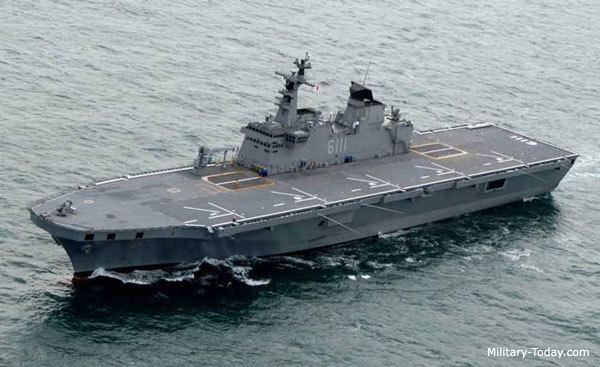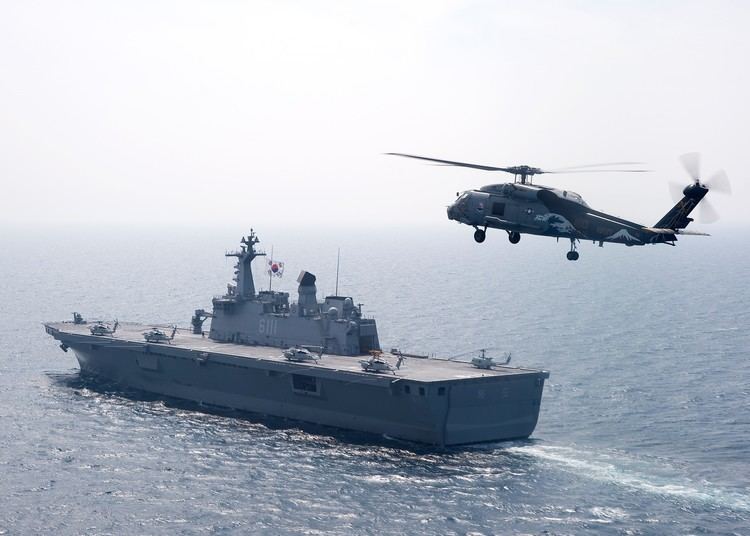Building 1 | Planned 3 | |
 | ||
Builders Hanjin Heavy Industries Cost KRW 325,770,000,000 (2005)US$ 288 million | ||
The Dokdo-class amphibious assault ship (Hangul: 독도급 강습상륙함, Hanja: 獨島級強襲上陸艦) is a class of Landing Platform Helicopter (LPH) amphibious assault ships operated by the Republic of Korea Navy (ROKN). Designed by Hanjin Heavy Industries, the requirements for the amphibious landing ships were to enhance South Korea's current amphibious operation capability, both in terms of assault and military operations other than war (MOOTW) type operations.
Contents

Development

The ROK Navy required a versatile landing ship with amphibious capabilities in its program to build a blue-water navy. In the end Hanjin's Dokdo design was chosen for this need. LSF-II 631-also built by Hanjin- was chosen as the LCAC to operate from the ship.
Specifications

The LPX is a versatile amphibious warfare ship which includes a well deck to accommodate Amphibious Assault Vehicles (AAVs) and two Landing Craft Air Cushion (LCAC), the first of which (LSF 631) was acquired in April 2007. The ship is 199 metres (652 ft 11 in) long, 31 metres (101 ft 8 in) wide, with a 14,000 ton (empty), or 18,000 ton (full) displacement and was also built incorporating stealth technologies. It has been said to be one of the most advanced vessels in the Asian Pacific.

As a high-speed amphibious ship, LPX was based on the concept of "over-the-horizon assault." As the name indicates, the "over-the-horizon assault" comprises a military operation in which an amphibious landing is conducted with high-speed air-cushioned vehicles and helicopters from beyond the horizon, where they can't be easily detected or attacked by the enemy. The conventional LST (landing ship tank) has to approach the coastline for landing, at the risk of being fired upon by the enemy.

The LPX can carry 720 marines (+300 crew members), 10 tanks, 10 trucks, 7 AAVs, three field artillery pieces, and two LCAC hovercraft capable of landing on enemy shores doing 40 knots (74 km/h)—a mix that enables it to launch troop landings from both sea and air. She can also carry 10 helicopters when there are no ground vehicles on her hangar deck.

The flight surface is also sprayed with urethane, which can support VTOL jets, like Harriers. South Korea is considering the purchase of F-35B fighters to operate from its Dokdo-class ships. Nowadays, the LPX operates mainly UH-1H and UH-60P. However, both of these are designed for land‐based operations and lack abilities for ship-borne operations such as protection against damage from salty breezes making them difficult to operate on-board continuously. The KUH-Amphibious, the sea-based amphibious variant of the KAI Surion, is now under development. Production is planned to commence in late 2015 with some 40 helicopters planned.
Self-defense armament includes the RIM-116 Rolling Airframe Missile system. The Goalkeeper Close-in weapon system (CIWS) was purchased in January 2003 from Thales, at a per-set price of 13,000,000,000 won (roughly $15,000,000).
Dokdo is similar in size to the light aircraft carriers derived from the Sea Control Ship such as the Spanish Navy's former aircraft carrier Príncipe de Asturias and the Royal Thai Navy's Chakri Naruebet.
Ships of the class
Three ships were planned at first, but the third ship was cancelled during the period of Lee Myung-bak government.
ROKS Dokdo (LPH-6111) is named after the Liancourt Rocks, which are called "Dokdo" in Korean but "Takeshima" in Japanese. Although the South Korean Coast Guard took control of the isles in 1954, Japan still disputes the sovereignty of the rocks.
The second unit, ROKS Marado, is named after Marado Island, commonly thought of as being both the ending and beginning point of the Korean Peninsula. Today a monument stands there recognizing it as the southernmost point of the country. This ship was cancelled once, but the budget was restored in 2012. A ski ramp for operations of V/STOL jet fighters is being considered for Marado.
The third unit was to be named after Baengnyeong Island, which is located in the Yellow Sea near the disputed Northern Limit Line (NLL) with North Korea. Baekryeong Island is the territory administered by South Korea that is closest to the NLL. It was an important military base and the site of fierce combat during the Korean War.
Plans
Some proposed uses for the ship include UN peacekeeping operations and disaster relief. For this reason, the LP-X is expected to usher in a new era of expanded South Korean naval activity, since it can be used for relief, transport, and other peacetime activities.
First Steps to a Blue Water Navy
In a speech delivered in March 2001, Kim Dae Jung stated that his administration was aiming to build a navy that "will defend the national interests in the five oceans and perform a role in defending world peace." By the year 2020, the ROK Navy plans to deploy two or three rapid response fleets, each comprising 1 Dokdo-class, 2 Sejong the Great-class, 4 Chungmugong Yi Sun-sin-class, 1 Gwanggaeto the Great-class, and possibly a number of Incheon-class frigates and two or three Type 214 submarine.
ROK Navy's Rapid Response Fleet:
